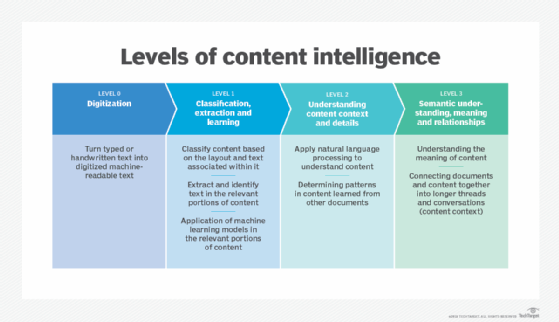
Sergey Nivens - Fotolia
AI in content management revolutionizes unstructured data
Managing content and data can take business process from unrefined to streamlined. Enterprises can slowly apply technologies to climb the ladder of cognitive content intelligence.
Organizations are drowning in data, with 90% of it in the form of unstructured data: documents, images, emails, online data and videos that aren't organized in a way that computers can easily process the information. And the data continues to grow at an astounding rate every year.
Organizations are continuing to try to gain intelligence from this treasure trove of valuable information, but because of the complexity in handling unstructured information, much of unstructured data goes unanalyzed. Valuable information is lost and unable to be used without requiring significant human labor to process and categorize it.
Forward-thinking enterprises are taking advantage of advancements in AI in content management, computing, storage and software technology to bring the necessary organization to their content. Specifically, the development of machine learning and AI has given rise to the ability to extract more value from the wide range of content in the enterprise by surfacing patterns within the information, unlocking content through natural language processing, and using recognition and other technologies to process image and video data.
Understanding the levels of content intelligence
Applying cognitive technologies to content is not an all-or-nothing effort, but rather something organizations can apply in levels of increasing cognitive capability. The greater the value an organization wants to get out of its content, the more advanced cognitive technology it needs to apply. Because of this, content intelligence is a journey organizations need to take -- increasing content value from data to increased application of cognitive technologies over time.
At the most basic level of content intelligence, content is simply digitized -- taken from its native format, such as photos or paper documents, and stored digitally. If organizations start with processes that are not particularly intelligent from a content perspective, they should work with the end goal of having an intelligent system that can process a wide range of content in many forms and provide the deep understanding that organizations need. Content intelligence organization aims to get systems to generate significant intelligence and value from content without requiring human intervention.
After basic levels, moving up the ladder of cognitive ability results in increasingly greater value to businesses by tackling increasingly harder business problems of increasingly more strategic value. The more AI-enabled an intelligent content service is, the more it can handle tasks that have previously been handled by employees.
The goal of content intelligence is to apply cognitive technologies to automatically understand and create meaning of unstructured content, transforming into structured data that can be connected into various systems and processes. In this way, AI in content management systems can help automate many of the situations that require human handling, eliminating errors and speeding up processes.

Content intelligence use cases
A wide range of industries are turning to content intelligence to glean value from their various forms of unstructured content. Purchase-to-pay processes, such as accounts receivable and accounts payable, are areas where content intelligence can have a huge impact on organizations. Because many companies make purchases or receive payments that are still paper-based, processing these documents is a time-consuming task for human employees.
Additionally, for larger companies that have hundreds or thousands of suppliers, content quickly adds up to several thousand invoices. By applying the appropriate intelligence to accounts payable and receivable processes, intelligent systems are doing more of the heavy lifting in helping companies create more efficient processes, with better accuracy at lower costs.
As organizations apply AI in content management intelligence to enterprise operations documents, like invoices, purchase orders or payment remittance, efficiencies and savings are quickly recognized. These intelligent systems are able to recognize and extract customer names, addresses, invoice terms and other necessary information located in invoices. Additionally, these tools can spot anomalies and identify relevant data in invoices. And they can assign them to various human workers for approvals or apply internal codes to pass them along to the next step in the payment process. Many vendors are currently providing services to help organizations gain more intelligence from current processes and documents.
Banking and financial institutions -- rabid AI consumers -- are moving toward digital transformation, with automated services to replace paper documents with digital ones. However, merely moving documents online doesn't go far enough. Many banking processes like onboarding new customers, processing a loan and verifying an individual or business identity involves processing content. These institutions need to move up the ladder of cognitive intelligence to better ensure they comply with Know Your Customer (KYC) requirements. When banks do not properly vet a new potential client, they can expose themselves to being out of compliance and face significant fines or penalties.
Content intelligence services allow these institutions to automatically process compliance or regulatory policies, complete and file the necessary paperwork, and make sure rules and regulations are not being violated. When a bank is doing business with a corporation or individual, there are many steps that must be performed to ensure compliance that become part of a KYC file, and many of these steps involve content from various documents. For banks that face large penalties for noncompliance or have other large potential risks, moving up the ladder of cognitive intelligence adds a lot of value.
Enterprises are striving to achieve the goals of digital transformation by combining digitized process, data, collaboration, mobility and intelligence to help companies take advantage of the rapidly evolving digital economy. Without content intelligence, digital transformation is just not possible. When combined with process automation, content intelligence provides the AI and cognitive machine learning capabilities and helps automate content-centric processes.





